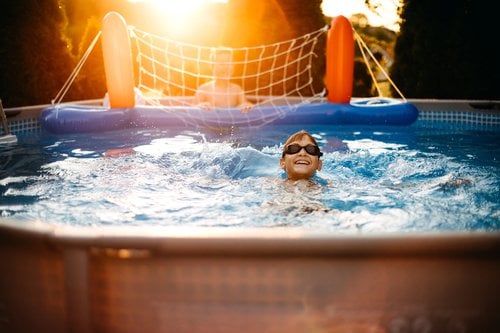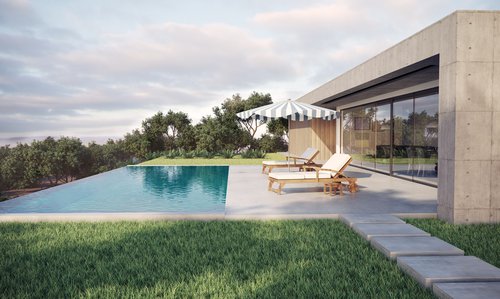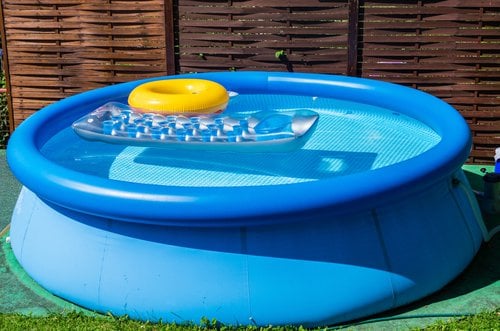Common types of home pools
While you probably can’t build an Olympic-sized structure in your backyard, you do have quite a few options when it comes to installing a pool. Here are some of the most common types you’ll see.
Above-ground pools

Often made from aluminum, resin or steel, above-ground pools sit on top of your yard, and may come with a patio, pool deck or locking gate.
These pools are typically less expensive, averaging around $1,500 without installation and close to $5,000 with installation. They’re also easier to assemble than other types of pools. Whereas you may need to hire a landscaper for certain water structures, you can DIY assemble an above-ground pool.
Above-ground pools don’t last as long as other options, and you usually can’t add things like a diving board or water slide. They also may actually decrease the value of your home because the ground underneath a pool often suffers, leaving an unsightly blob of dead grass or damaged surfaces.
In-ground pools
Typically made of concrete, fiberglass or vinyl-liner pools, in-ground pools are permanent additions to the home, built directly into the lawn or landscape. Your home may have certain rules about altering the landscaping, so be sure to check before making a major purchase.
These pools tend to be more expensive but more durable than above-ground pools. A vinyl-liner pool will start at about $35,000, while concrete pools can surpass $100,000 in total cost. However, they’ll typically add value to your home, too.
In-ground pools offer more landscaping flexibility. Since they don’t come pre-built, you can fit them in most yards. Additionally, you can potentially add fixtures such as diving boards, water fountains and slides.
One thing to watch out for: Since in-ground pools are closer to ground level, young kids and pets can wander into the water more easily. If you don’t have a fence or other secure perimeter, never leave anyone who isn't a strong swimmer unattended near the pool.
Hot tubs and home spas
The biggest difference between hot tubs and home spas is where they are in relation to the ground. Hot tubs are above-ground, while home spas are in-ground. In both cases, you’ll use them to relax and soothe achy muscles.
Since hot tubs and home spas take up less surface area — and, in the case of hot tubs, are portable — they generally don’t cost as much as a full pool, both to install and maintain. They also tend to be a bit less durable, but are still a nice way to stay warm on cooler nights.
Infinity pools

If you really want to be extravagant, an infinity pool might be the right choice.
Infinity pools look particularly cool if they’re built by a steep drop-off. That way, the water appears to endlessly flow down the wall. It also provides picturesque scenery if you live near a mountainside or lake. And what’s more romantic than watching fireworks in the sky while relaxing in your pool?
However, the complexity of infinity pools means they’re pricier to install and maintain. And if you don’t have a lot of yard space, it might be difficult (if not impossible) to create the effect of an infinity pool.
Inflatable pools

Technically an above-ground pool, inflatable pools are a nice alternative to making a major pool investment. While some inflatable options include things like mini-jets or filtration systems, at their core, inflatable pools only require two things: a way to blow them up to full-size and a hose for filling them with water.
Because they’re designed to be blown up and then deflated after use, inflatable pools are typically inexpensive (under $100) and can be placed just about anywhere in the yard. However, that cheaper cost often means cheaper materials, and it’s easy for an inflatable pool to wear out or experience a tear.
Cowboy or stock tank pools
This one is also technically a version of an above-ground pool. It can be a cheaper DIY option, as the average stock tank costs less than $300. But you will still need to do some research to do it right.
First the ground needs to be level and able to support the weight of the filled tank. You will also need a pump and chemicals to keep the water clean. It's better to put the stock tank pool in a shady spot because the water will heat up quickly in the summer time.
With a little know-how though, a stock tank pool can be an easy-to-install option for a summer time dip.





